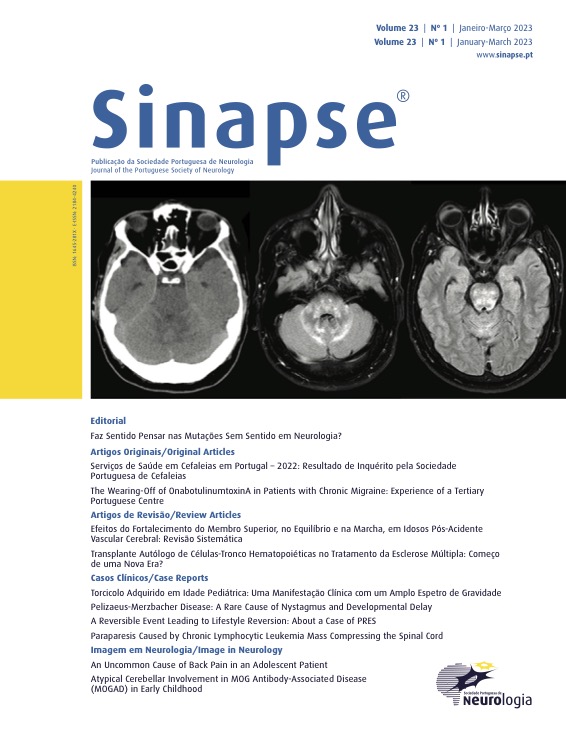The Wearing-Off of OnabotulinumtoxinA in Patients with Chronic Migraine: Experience of a Tertiary Portuguese Centre
DOI:
https://doi.org/10.46531/sinapse/AO/220079/2023Keywords:
Botulinum Toxins, Type A/ therapeutic use, Chronic Pain/drug therapy, Migraine Disorders/drug therapy, Migraine Disorders/prevention & controlAbstract
Introduction: The onabotulinumtoxinA (onabotA) is an injectable preventive treatment of chronic migraine (CM), administered in 12 week’s intervals. Some patients present a wearing-off (WO) effect in the last weeks before the next treatment. The aim of our study was to evaluate the WO phenomen in patients under onabotA treatment and to recognize possible predictive features of the phenomena.Methods: We designed a cross-sectional study and proceeded to demographic and clinical characterization of a group of patients, and evaluation of onabotA therapeutic response and adverse events. WO effect was defined as the loss of therapeutic effect, that consists of reduction equal or greater than 50% in the number of headache days, before the 12-week interval. Statistical testing was carried out using a level of significance of p<0.05.
Results: We included 60 patients (95.1% female) with a mean age of 49.0±11.4 years. On average, before onaBotA treatment patients had around 15.0 attacks per month. In 45.3% we noticed a therapeutic response after the first treatment. The WO effect was noticed in 36 patients (66.7%) and the majority (50.9%) between the 10th to 12th week post treatment. Wearing-off was more reported by patients under 155 units PREEMPT protocol (p=0.032).
Conclusion: This study documents the high frequency of WO phenomen in patients with chronic migraine under onabotA. Therefore, the possibility of a different protocol in selected patients must be explore with larger observational and prospective studies as well as evaluation in clinical trials.
Downloads
References
GBD 2019 Diseases and Injuries Collaborators. Global burden of 369 diseases and injuries in 204 countries and territories, 1990–2019: a systematic analysis for the Global Burden of Disease Study 2019. Lancet. 2020; 396:1204–22. doi: 10.1016/S0140-6736(20)30925-9.
Burch RC, Buse DC, Lipton RB. Migraine: epidemiology, burden, and comorbidity. Neurol Clin. 2019;37:631-49. doi: 10.1016/j.ncl.2019.06.001.
Vos T, Flaxman AD, Naghavi M, Lozano R, Michaud C, Ezzati M, et al. Years lived with disability (YLDs) for 1160 sequelae of 289 diseases and injuries 1990-2010: a systematic analysis for the Global Burden of Disease Study 2010. Lancet. 2012;380:2163-96. doi: 10.1016/S0140-6736(12)61729-2. Erratum in: Lancet. 2013;381:628.
Martins I. Cefaleias. Lidel: Lisboa; 2015.
Ashina M. Migraine. N Engl J Med. 2020; 11:1866–76. doi:10.1056/NEJMra1915327.
The International Classification of Headache Disorders, 3rd edition (ICHD-3). Cephalalgia. 2018;38:1–211. doi: 10.1177/0333102417738202
Adams AM, Serrano D, Buse DC, Reed ML, Marske V, Fanning KM, et al. The impact of chronic migraine: The Chronic Migraine Epidemiology and Outcomes (CaMEO) Study methods and baseline results. Cephalalgia. 2015;35:563-78. doi: 10.1177/0333102414552532.
Herd CP, Tomlinson CL, Rick C, Scotton WJ, Edwards J, Ives NJ, et al. Cochrane systematic review and meta-analysis of botulinum toxin for the prevention of migraine. BMJ Open. 2019;9:e027953. doi: 10.1136/bmjopen-2018-027953.
Aurora SK, Dodick DW, Turkel CC, DeGryse RE, Silberstein SD, Lipton RB, et al. OnabotulinumtoxinA for treatment of chronic migraine: results from the double-blind, randomized, placebo-controlled phase of the PREEMPT 1 trial. Cephalalgia. 2010;30:793-803. doi: 10.1177/0333102410364676.
Diener HC, Dodick DW, Aurora SK, Turkel CC, DeGryse RE, Lipton RB, et al. OnabotulinumtoxinA for treatment of chronic migraine: results from the double-blind, randomized, placebo-controlled phase of the PREEMPT 2 trial. Cephalalgia. 2010;30:804-14. doi: 10.1177/0333102410364677.
Matak I, Bach-Rojecky L, Filipović B, Lacković Z. Behavioral and immunohistochemical evidence for central antinociceptive activity of botulinum toxin A. Neuroscience. 2011;186:201-7. doi: 10.1016/j.neuroscience.2011.04.026.
Khan FA, Mohammed AE, Poongkunran M, Chimakurthy A, Pepper M. Wearing off effect of onabotulinumtoxina near the end of treatment cycle for chronic migraine: a 4-year clinical experience. Headache. 2020;60:430-40. doi: 10.1111/head.13713.
Ruscheweyh R, Athwal B, Gryglas-Dworak A, Frattale I, Latysheva N, Ornello R, et al. Wear-Off of OnabotulinumtoxinA Effect Over the Treatment Interval in Chronic Migraine: A Retrospective Chart Review With Analysis of Headache Diaries. Headache. 2020;60:1673-82. doi: 10.1111/head.13925.
Becker W. Botulinum toxin in the treatment of headache. Toxins. 2020; 12:803. doi: 10.3390/toxins12120803.
Quintas S, García-Axorín D, Heredia P, Talavera B, Gago-Veiga AB, Guerrero ÁL. Wearinf off responde to onabotulinumtoxin a in chronic migraine: analysis in a series of 193 patients. Pain Med. 2019; 20:1815-21. doi: 10.1093/pm/pny282.
Downloads
Published
How to Cite
Issue
Section
License

This work is licensed under a Creative Commons Attribution-NonCommercial 4.0 International License.








